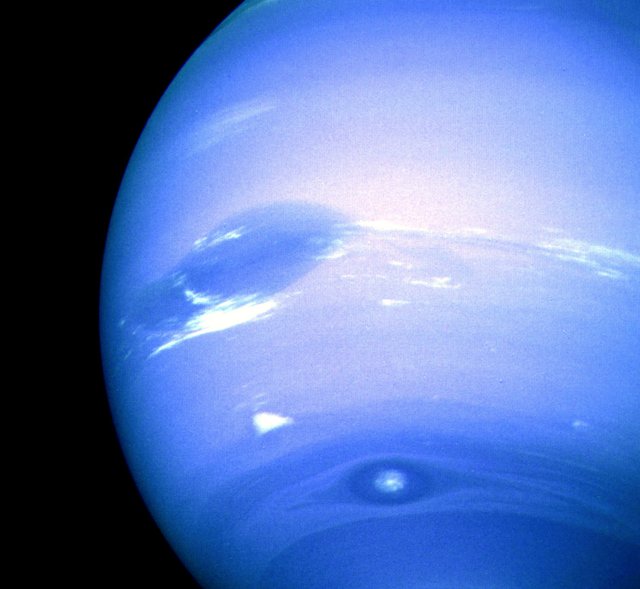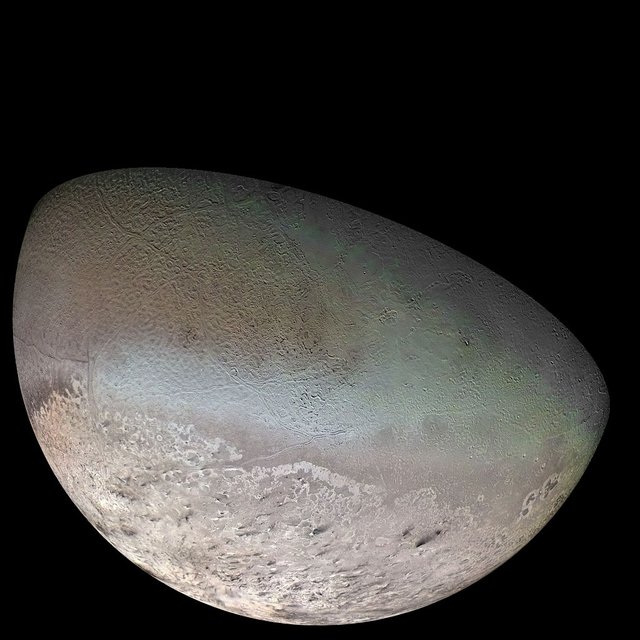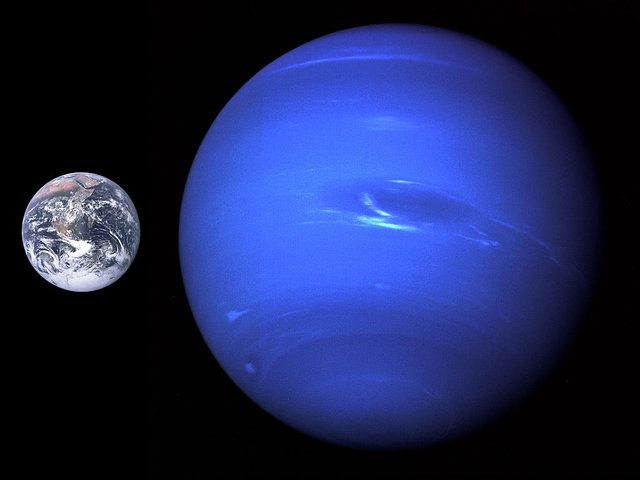Neptune - giant at the ends of the solar system
I will describe for you this time the 8th planet of our Solar System. It is the smallest and most distant of gaseous giants. However, it arouses great interest among astronomers, because it has a very active atmosphere and the moon, on which volcanoes spit nitrogen instead of lava.

By NASA link [Public domain]
The planet was discovered in 1846. The Voyager 2 spacecraft approached the last solar planet of the Solar System on August 25, 1989. Instead of a peaceful, structureless, smooth globe like Uranus, astronomers saw a blue ball with a giant navy blue stain and numerous layers of white, storm clouds. Neptune is the smallest gas giant, and yet its mass is 17 times greater than Earth. The structure and chemical composition of Neptune are similar to the construction of its larger brother - Uranus. The rocky core is surrounded by a cloak of water, ammonia and methane, but here it is already in the form of ice. The atmosphere of the planet consists of hydrogen, helium and methane.

By NASA/Voyager 2 Team link [Public domain]
Neptune differently than Uranus emits twice as much energy than it receives from the Sun, so it has an internal source of heat. Although Neptune lies two times farther from the Sun than Uranus, its temperature under the atmosphere is about - 200 degrees Celsius (on Uranus about -224 * C). This internal heat drives planetary winds of up to 600 m / s (2,160 km / h) and causes violent thunderstorms. When Voyager 2 began to observe Neptune in 1989, its southern hemisphere contained a huge system of high pressure (dark spot), surrounded by white storm clouds. In 1995, Neptune was observed using the Hubble Space Telescope. This confirmed the dynamic nature of the planet. The dark spot and storm clouds disappeared, and other similar creatures appeared in their place. Neptune has delicate rings, but they are virtually invisible.

By NASA / Jet Propulsion Lab / U.S. Geological Survey link [Public domain]
The largest moon of Neptune is Triton. Its diameter is 2,700 km, which is a bit smaller than our Moon. On the surface of Triton, the temperature drops to -240 degrees Celsius! Its construction resembles the last dwarf planet Pluto. There are commonly known impact craters on Triton. There are also geysers that shoot the rare atmosphere of a nitrogen fountain for 8 km high! The ejected matter falls around the geysers, creating their dark places. The satellite revolves around Neptune in the opposite direction of the movement of the planet. This may mean that Triton was once captured by Neptune. He could be a free body like the dwarf planet Pluto.

By NASA link [Public domain]
At the end, a comparison of the size of Neptune and Earth. The smallest gas planet is still a giant next to Earth. This 4.5 billion km away from the Sun is beyond the reach of current research missions. I will add that due to the great distance, Neptun performs a full lap around the Sun in nearly 165 years! Year on Neptune is very long, right? Imagine how this planet is far away. The radio signal from Mars to us goes to us for about 20 minutes. During the Voyager 2 flight, signals from Neptune needed 246 minutes to reach Earth. That is why most of Neptune's research, Voyager 2, was performed only by pre-programmed activities.
Greetings to lovers of Astronomy!
References:

This post has been voted on by the SteemSTEM curation team and voting trail in collaboration with @curie.
If you appreciate the work we are doing then consider voting both projects for witness by selecting stem.witness and curie!
For additional information please join us on the SteemSTEM discord and to get to know the rest of the community!
Good Stuff I love astronomy I should take a copy and send it to my 7 year old grandson he wants to be an astronaut he would love it and you keep up the good studies. I will watch for you
Astronomy is a beautiful hobby. Thank you and best regards